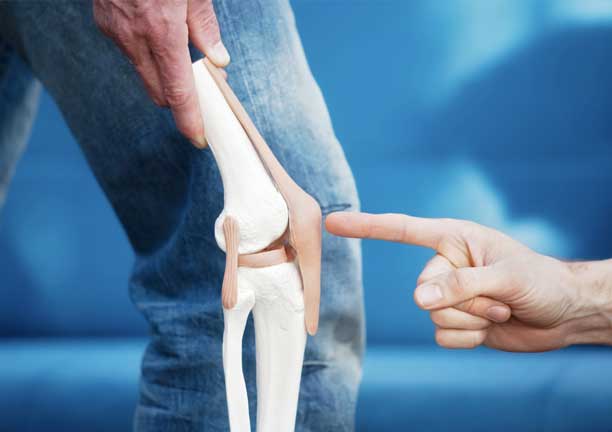Quadriceps tendon repair is typically needed for individuals who have sustained an injury or tear in the quadriceps tendon. Read on to learn more about general post op protocols, what the best sleeping options are post op, when one can expect to walk and exercise post op, as well as tips on speeding up recovery.
The quadriceps tendon is a thick, strong tendon that connects the quadriceps muscles in the thigh to the patella (kneecap). This tendon is essential for normal knee function and allows for movements such as running, jumping, and walking.
Quadriceps tendon injuries can be sustained due to a number of reasons, including:
- A sudden force or direct blow to the knee, such as during a fall, sports-related injury, or automobile accident, can cause a tear in the quadriceps tendon.
- Repetitive stress on the quadriceps tendon over time which can lead to chronic degeneration or gradual weakening of the tendon. This type of degeneration is more commonly seen in older individuals or those with certain medical conditions like tendinitis or systemic disorders.
Individuals who may require quadriceps tendon repair often experience symptoms such as severe pain, swelling, difficulty walking or extending the knee, and a noticeable gap or indentation above the patella where the tendon has torn. Quadriceps tendon surgical repair is typically recommended for individuals who have significant tears or complete ruptures of the tendon.
What does typical Quadricep tendon repair post op protocol look like?
The postoperative recovery for Quadricep tendon repair may vary depending on the surgeon’s preferences, the extent of the injury, and individual patient factors. A general outline of a typical postoperative protocol for quadriceps tendon repair looks something like this:
Immobilization
Following surgery, the knee is usually placed in a hinged knee brace or a cast to protect the repair and promote healing. The immobilization period may last for several weeks, during which weight-bearing is restricted or completely prohibited.
Ice and Elevation
Ice therapy and elevation are commonly recommended to reduce pain, swelling, and inflammation. Ice packs or using an ice machine can be applied to the surgical site for 15-20 minutes at a time and elevating the leg above heart level can help in the early stages of recovery.
Pain Management
Pain medications or nonsteroidal anti-inflammatory drugs (NSAIDs) may be prescribed to manage postoperative pain and discomfort. It’s important to follow the prescribed medication regimen and consult with the surgeon before taking any over-the-counter medications.
Physical Therapy
Physical therapy plays a crucial role in the rehabilitation process. Once the initial healing period has passed, a physical therapist will guide the patient through a structured rehabilitation program. Initially, therapy focuses on gentle range-of-motion exercises and strengthening exercises for the surrounding muscles without putting stress on the repaired tendon.
Gradual Weight-Bearing
Weight-bearing is gradually reintroduced under the guidance of a physical therapist or surgeon. This typically starts with partial weight-bearing using crutches or a walker and progresses to full weight-bearing as tolerated.
Progressive Exercises
As the healing progresses, the physical therapy program will incorporate more advanced exercises to improve strength, flexibility, and balance. These exercises may include leg presses, squats, lunges, and functional activities specific to the patient’s needs and goals.
What are the best sleeping options after Quadriceps tendon repair?
Sleeping after quadriceps tendon repair can be challenging due to the need to protect the healing tendon and minimize stress on the surgical site. Here are some tips that may help you find a comfortable sleeping position:
Back Sleeping
Sleeping on your back is generally recommended after quadriceps tendon repair as it minimizes stress on the knee joint. Use pillows to support your head and neck comfortably.
Elevated Position
To reduce swelling, elevate your leg by placing a few pillows or a wedge pillow under your calf and heel. This elevation can help with fluid drainage and decrease discomfort.
Pillows for Support
Use pillows strategically to provide support and reduce strain on the surgical site. Place pillows under your operated leg to keep it elevated and supported. You may also consider using a small pillow or rolled-up towel under your knee to maintain a slight bend in the knee joint.
Avoid Side Sleeping
Side sleeping can put pressure on the repaired tendon and the knee joint. It’s generally recommended to avoid sleeping on the side of the operated leg, especially in the early stages of recovery.
Use a Knee Brace or Splint
Depending on your surgeon’s recommendations, you may be provided with a knee brace or a splint to wear while sleeping. This can provide additional support and stabilization to the knee during the healing process.
Pain Management
Take pain medication or follow any prescribed pain management regimen as directed by your healthcare provider before bedtime. This can help reduce discomfort and promote better sleep.
When can one expect to walk after Quadriceps tendon repair?
The timing for walking after quadriceps tendon repair can vary depending on several factors, including the extent of the injury, the surgical technique used, the surgeon’s preferences, and the individual patient’s progress. In general, the initial period after surgery involves immobilization and limited or no weight-bearing to allow for initial healing.
After the initial immobilization phase, the surgeon will provide guidance on when weight-bearing and walking can be initiated. This typically involves a gradual progression from non-weight-bearing to partial weight-bearing and eventually to full weight-bearing.
The specific timeline for walking after quadriceps tendon repair can vary, but it is typically as follows:
- Non-Weight-Bearing (NWB): In the immediate postoperative period, patients are often instructed to avoid placing any weight on the affected leg. Crutches, a walker, or a knee scooter may be used for mobility.
- Partial Weight-Bearing (PWB): After a period of non-weight-bearing, the surgeon may allow partial weight-bearing. This means that the patient can begin to put a limited amount of weight on the leg, usually with the assistance of crutches or a walker. The amount of weight allowed is determined by the surgeon’s instructions.
- Full Weight-Bearing (FWB): Once the quadriceps tendon has sufficiently healed and the surgeon gives the go-ahead, the patient can progress to full weight-bearing. At this stage, the patient can walk without any assistance, but it’s important to follow any guidelines provided by the surgeon or physical therapist regarding gait and activity modifications.
When can you exercise after quadriceps tendon repair?
Early Stage: In the early stages of recovery, the focus is on protecting the healing tendon and gradually restoring range of motion. This typically involves gentle exercises prescribed by the physical therapist, such as passive or assisted range-of-motion exercises. These exercises help prevent stiffness and promote healing without placing stress on the repair.
- Strengthening Exercises: As the healing progresses, the physical therapy program will include specific exercises to strengthen the quadriceps muscles and the surrounding muscles of the leg. This may involve exercises like straight leg raises, quadriceps sets, and other exercises targeting the thigh muscles. Initially, these exercises may be performed with low resistance or bodyweight only, gradually progressing to resistance bands or weights as tolerated.
- Balance and Proprioception: Regaining balance and proprioception (awareness of joint position) is an important aspect of rehabilitation. Exercises such as single-leg stands, balance board exercises, and stability exercises may be introduced to improve stability and prevent future injuries.
- Functional and Sports-Specific Activities: As the quadriceps tendon heals and strength improves, the physical therapist may incorporate functional activities and sports-specific exercises into the rehabilitation program. These exercises are tailored to the patient’s specific needs and goals, focusing on movements and activities relevant to their daily life or sporting activities.
The timing for starting exercise after quadriceps tendon repair will vary, but it typically begins several weeks after surgery, once sufficient healing has occurred. The specific exercises, intensity, and progression will be determined by the physical therapist overseeing your rehabilitation.
What are some tips for speeding up recovery after quadriceps tendon repair?
While the recovery process after quadriceps tendon repair takes time and varies for each individual, there are several tips that may help promote healing and potentially speed up the recovery process. Here are some suggestions:
Follow Postoperative Instructions
Strictly adhere to the postoperative instructions provided by your surgeon. This includes taking prescribed medications as directed, attending follow-up appointments, and following any restrictions or limitations on weight-bearing, movement, or activities.
Rest and Protect the Knee
Allow your knee to rest and avoid activities that may put stress on the healing tendon. Use assistive devices such as crutches, walkers, or knee scooters, as recommended by your healthcare provider, to minimize weight-bearing and protect the repair.
Physical Therapy
Engage in a structured physical therapy program tailored to your specific needs and guided by a qualified physical therapist. Physical therapy helps in restoring range of motion, strength, and function. Be diligent in attending therapy sessions and performing prescribed exercises both during sessions and at home.
Manage Swelling
Swelling is common after surgery and can delay the healing process. Elevate your leg and use ice packs as recommended to reduce swelling. Compressing the knee with an elastic bandage or wearing a compression sleeve may also be beneficial, but consult your healthcare provider for appropriate recommendations.
Nutrition and Hydration
Proper nutrition and hydration are essential for optimal healing. Eat a well-balanced diet rich in nutrients, including lean proteins, fruits, vegetables, and whole grains. Adequate hydration supports tissue repair and overall health.
Quit Smoking
If you smoke, consider quitting or reducing your smoking habits. Smoking can impair the healing process and increase the risk of complications. Consult with your healthcare provider for support or resources if needed.
Maintain a Healthy Lifestyle
Engage in overall healthy habits to support healing and recovery. Get adequate sleep, manage stress levels, and avoid excessive alcohol consumption. These factors can positively impact your body’s ability to heal.
Follow Precautions
Follow any precautions provided by your surgeon to protect the repaired tendon. This may include avoiding certain movements, activities, or positions that could strain the tendon.
Patience and Gradual Progression
While it’s natural to want to speed up recovery, it’s important to be patient and allow your body the necessary time to heal. Pushing too hard or rushing the recovery process can potentially lead to complications or setbacks. Gradually progress through rehabilitation milestones as advised by your healthcare team.



















